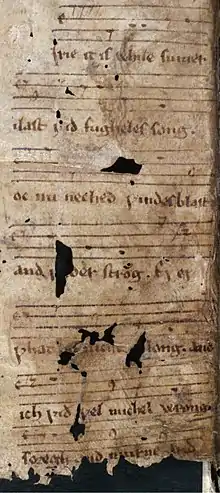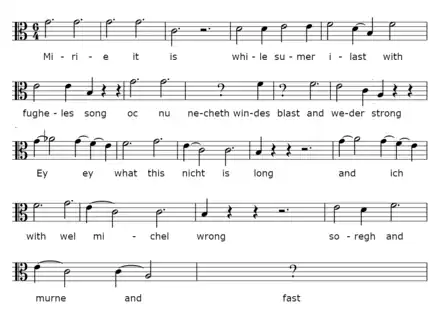
“Mirie it is while sumer ilast” (“Merry it is while summer ylast”) is a Middle English song of the first half of the 13th century. It is about the longing for summer in the face of the approaching cold weather. It is one of the oldest songs in the English language, and one of the few examples of non-liturgical music from medieval England.[1] The manuscript was found together with two old French songs in a book of Psalms in the Bodleian Library. It was rediscovered at the end of the 19th century and made accessible to experts in 1901. It was arranged and published in a modern form for the first time by Frank Llewellyn Harrison.[2]
The text and melody are incomplete on a single, damaged manuscript page, which, together with the somewhat ambiguous notation, makes it difficult to reconstruct the song in whole. It is unclear whether the song originally contained additional lines or stanzas, which Harrison considers probable,[3] nor can the final word be conclusively determined.[2] The author of the song is also unknown, although by its inclusion with two other French love songs pasted in a Book of Psalms, Nicholson proposes that the manuscript was written by lay chorister.[4] The context of the piece also may suggest the surviving leaf was originally included in a French chansonnier, suggesting an origin in the French tradition.[5]
Words
[M]irie it is while sumer ilast
with fugheles song.
oc nu necheth windes blast
and w[ed]er strong.
Ey ey what this nicht [is] long.
And ich with wel michel wrong
soregh and murne and [fast.]
Modern spelling
Merry it is while summer ylast
With fowl’s song.
Oc now nigheth wind’s blast
And weather strong.
Ay, ay! What this night is long.
And I with well mickle wrong
Sorrow and mourn and fast.[6]
Melody

See also
- Sumer is icumen in, another 13th century medieval English song on a related theme.
References
- ↑ Karl Reichl, Die Anfänge der mittelenglischen weltlichen Lyrik: Text, Musik, Kontext, Ferdinand Schöningh, Paderborn, 2005.
- 1 2 "Mirie it is while sumer ilast: Decoding the earliest surviving secular song in English (Revised and updated)". 24 August 2018.
- ↑ A. I. Doyle, Late-medieval Religious Texts and Their Transmission, p. 59.
- ↑ E. W. B. Nicholson, Introduction, in J. F. R. Stainer, C. Stainer, Early Bodleian Music: Sacred and Secular Songs together with other MS. Compositions in the Bodleian Library, Oxford, ranging from about A.D. 1185 to about A.D. 1505. I: Facsimiles, Gregg, Farnborough 1967, p. xi.
- ↑ F. Ll. Harrison, Medieval English Songs, Faber, London,1979, p. 297.
- 1 2 "Medieval Lyrics - Faculty Home Pages".
- ↑ "Mirie it is - Merry it is (Middle English Lyric)".
- ↑ J. F. R. Stainer, C. Stainer, Early Bodleian Music: Sacred and Secular Songs together with other MS. Compositions in the Bodleian Library, Oxford, ranging from about A.D. 1185 to about A.D. 1505. I: Facsimiles, Gregg, Farnborough 1967.